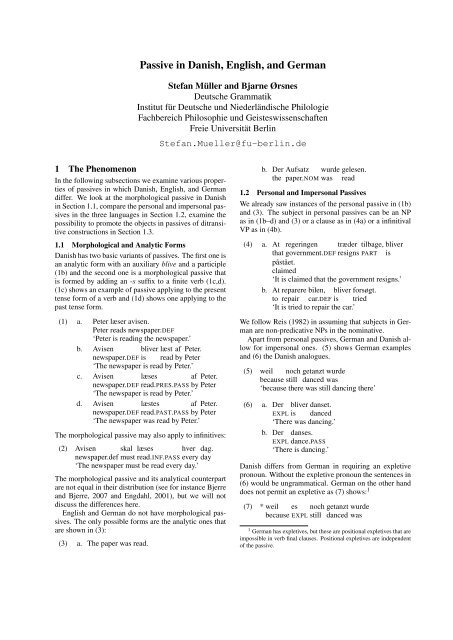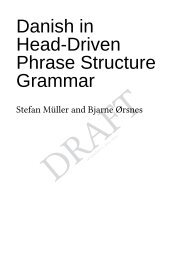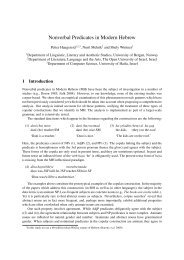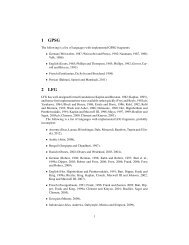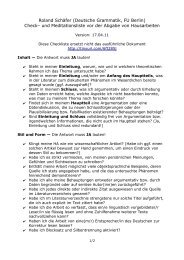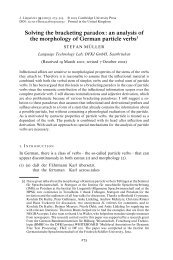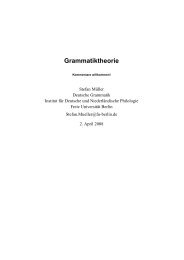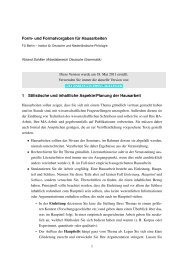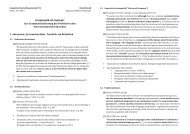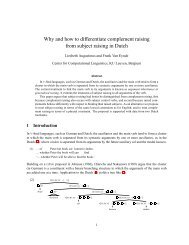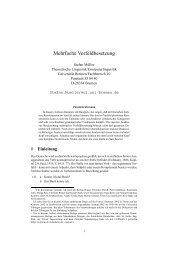Passive in Danish, English, and German - German Grammar Group ...
Passive in Danish, English, and German - German Grammar Group ...
Passive in Danish, English, and German - German Grammar Group ...
Create successful ePaper yourself
Turn your PDF publications into a flip-book with our unique Google optimized e-Paper software.
<strong>Passive</strong> <strong>in</strong> <strong>Danish</strong>, <strong>English</strong>, <strong>and</strong> <strong>German</strong><br />
Stefan Müller <strong>and</strong> Bjarne Ørsnes<br />
Deutsche Grammatik<br />
Institut für Deutsche und Niederländische Philologie<br />
Fachbereich Philosophie und Geisteswissenschaften<br />
Freie Universität Berl<strong>in</strong><br />
1 The Phenomenon<br />
In the follow<strong>in</strong>g subsections we exam<strong>in</strong>e various properties<br />
of passives <strong>in</strong> which <strong>Danish</strong>, <strong>English</strong>, <strong>and</strong> <strong>German</strong><br />
differ. We look at the morphological passive <strong>in</strong> <strong>Danish</strong><br />
<strong>in</strong> Section 1.1, compare the personal <strong>and</strong> impersonal passives<br />
<strong>in</strong> the three languages <strong>in</strong> Section 1.2, exam<strong>in</strong>e the<br />
possibility to promote the objects <strong>in</strong> passives of ditransitive<br />
constructions <strong>in</strong> Section 1.3.<br />
1.1 Morphological <strong>and</strong> Analytic Forms<br />
<strong>Danish</strong> has two basic variants of passives. The first one is<br />
an analytic form with an auxiliary blive <strong>and</strong> a participle<br />
(1b) <strong>and</strong> the second one is a morphological passive that<br />
is formed by add<strong>in</strong>g an -s suffix to a f<strong>in</strong>ite verb (1c,d).<br />
(1c) shows an example of passive apply<strong>in</strong>g to the present<br />
tense form of a verb <strong>and</strong> (1d) shows one apply<strong>in</strong>g to the<br />
past tense form.<br />
(1) a. Peter læser avisen.<br />
Peter reads newspaper.DEF<br />
‘Peter is read<strong>in</strong>g the newspaper.’<br />
b. Avisen bliver læst af Peter.<br />
newspaper.DEF is read by Peter<br />
‘The newspaper is read by Peter.’<br />
c. Avisen læses af Peter.<br />
newspaper.DEF read.PRES.PASS by Peter<br />
‘The newspaper is read by Peter.’<br />
d. Avisen læstes af Peter.<br />
newspaper.DEF read.PAST.PASS by Peter<br />
‘The newspaper was read by Peter.’<br />
The morphological passive may also apply to <strong>in</strong>f<strong>in</strong>itives:<br />
(2) Avisen skal læses hver dag.<br />
newspaper.def must read.INF.PASS every day<br />
‘The newspaper must be read every day.’<br />
The morphological passive <strong>and</strong> its analytical counterpart<br />
are not equal <strong>in</strong> their distribution (see for <strong>in</strong>stance Bjerre<br />
<strong>and</strong> Bjerre, 2007 <strong>and</strong> Engdahl, 2001), but we will not<br />
discuss the differences here.<br />
<strong>English</strong> <strong>and</strong> <strong>German</strong> do not have morphological passives.<br />
The only possible forms are the analytic ones that<br />
are shown <strong>in</strong> (3):<br />
(3) a. The paper was read.<br />
Stefan.Mueller@fu-berl<strong>in</strong>.de<br />
b. Der Aufsatz wurde gelesen.<br />
the paper.NOM was read<br />
1.2 Personal <strong>and</strong> Impersonal <strong>Passive</strong>s<br />
We already saw <strong>in</strong>stances of the personal passive <strong>in</strong> (1b)<br />
<strong>and</strong> (3). The subject <strong>in</strong> personal passives can be an NP<br />
as <strong>in</strong> (1b–d) <strong>and</strong> (3) or a clause as <strong>in</strong> (4a) or a <strong>in</strong>f<strong>in</strong>itival<br />
VP as <strong>in</strong> (4b).<br />
(4) a. At reger<strong>in</strong>gen træder tilbage, bliver<br />
that government.DEF resigns PART<br />
påstået.<br />
claimed<br />
is<br />
‘It is claimed that the government resigns.’<br />
b. At reparere bilen, bliver forsøgt.<br />
to repair car.DEF is tried<br />
‘It is tried to repair the car.’<br />
We follow Reis (1982) <strong>in</strong> assum<strong>in</strong>g that subjects <strong>in</strong> <strong>German</strong><br />
are non-predicative NPs <strong>in</strong> the nom<strong>in</strong>ative.<br />
Apart from personal passives, <strong>German</strong> <strong>and</strong> <strong>Danish</strong> allow<br />
for impersonal ones. (5) shows <strong>German</strong> examples<br />
<strong>and</strong> (6) the <strong>Danish</strong> analogues.<br />
(5) weil noch getanzt wurde<br />
because still danced was<br />
‘because there was still danc<strong>in</strong>g there’<br />
(6) a. Der bliver danset.<br />
EXPL is danced<br />
‘There was danc<strong>in</strong>g.’<br />
b. Der danses.<br />
EXPL dance.PASS<br />
‘There is danc<strong>in</strong>g.’<br />
<strong>Danish</strong> differs from <strong>German</strong> <strong>in</strong> requir<strong>in</strong>g an expletive<br />
pronoun. Without the expletive pronoun the sentences <strong>in</strong><br />
(6) would be ungrammatical. <strong>German</strong> on the other h<strong>and</strong><br />
does not permit an expletive as (7) shows: 1<br />
(7) * weil es noch<br />
because EXPL still<br />
getanzt wurde<br />
danced was<br />
1 <strong>German</strong> has expletives, but these are positional expletives that are<br />
impossible <strong>in</strong> verb f<strong>in</strong>al clauses. Positional expletives are <strong>in</strong>dependent<br />
of the passive.
(8) a. * Bliver danset.<br />
is danced<br />
b. * Danses.<br />
dance.PASS<br />
The reason for this difference is due to a typological difference<br />
between the languages: <strong>Danish</strong> is an SVO language<br />
while <strong>German</strong> is a SOV language. <strong>Danish</strong>, like<br />
<strong>English</strong>, requires the subject position to be filled. While<br />
<strong>English</strong> simply does not allow for passives if there is no<br />
element that could be promoted to subject, <strong>Danish</strong> <strong>in</strong>serts<br />
an expletive subject.<br />
The examples <strong>in</strong> (5) <strong>and</strong> (6) show passives of monovalent<br />
verbs but of course bi-valent <strong>in</strong>transitive verbs like<br />
the <strong>German</strong> denken (‘th<strong>in</strong>k’) <strong>and</strong> <strong>Danish</strong> passe (‘take<br />
care of’) also form impersonal passives:<br />
(9) dass an die Männer gedacht wurde<br />
that PREP the men thought was<br />
‘that one thought about the men’<br />
(10) a. Der passes<br />
på<br />
EXPL take.care.of.PRES.PASS on<br />
børnene.<br />
children.DEF<br />
‘Somebody takes care of the children.’<br />
b. Der bliver passet på børnene.<br />
EXPL is taken.care.of on children.DEF<br />
‘Somebody takes care of the children.’<br />
1.3 Direct <strong>and</strong> Indirect Objects<br />
While <strong>German</strong> <strong>and</strong> <strong>English</strong> do not allow for the promotion<br />
of the <strong>in</strong>direct object to subject <strong>in</strong> passives with the<br />
cannonical auxiliary, both the direct <strong>and</strong> <strong>in</strong>direct object<br />
can be promoted to subject <strong>in</strong> <strong>Danish</strong>. The follow<strong>in</strong>g<br />
<strong>German</strong> examples show that the dative object cannot be<br />
promoted to subject <strong>in</strong> passives with werden:<br />
(11) a. weil der Mann dem Jungen den<br />
because the man.NOM the boy.DAT the<br />
Ball schenkt<br />
ball.ACC gives.as.a.present<br />
‘because the man gives the boy the ball as a<br />
present’<br />
b. weil dem Jungen der Ball<br />
because the boy.DAT the ball.NOM<br />
geschenkt wurde<br />
given.as.a.present was<br />
‘because the boy was given the ball as a<br />
present’<br />
c. * weil der Junge den Ball<br />
because the boy.NOM the ball.ACC<br />
geschenkt wurde<br />
given.as.a.present was<br />
Intended: ‘because the ball was given to the<br />
boy as a present’<br />
The same is true for the <strong>in</strong>direct object <strong>in</strong> <strong>English</strong>: While<br />
the direct object can be promoted to subject as <strong>in</strong> (12a),<br />
promot<strong>in</strong>g the <strong>in</strong>direct object as <strong>in</strong> (12b) is ungrammatical.<br />
2<br />
(12) a. because the boy was given the ball<br />
b. * because the ball was given the boy<br />
The <strong>in</strong>tended <strong>in</strong>formation structural effect can be<br />
reached though by us<strong>in</strong>g the dative shift construction <strong>in</strong><br />
(13a) <strong>and</strong> passiviz<strong>in</strong>g the verb that takes an NP <strong>and</strong> a PP<br />
object:<br />
(13) a. because the man gave the ball to the boy<br />
b. becaue the ball was given to the boy<br />
<strong>Danish</strong> allows for the promotion of either argument:<br />
(14) a. fordi m<strong>and</strong>en giver drengen bolden<br />
because man.DEF gives boy.DEF ball.DEF<br />
‘because the man gives the boy the ball’<br />
b. fordi drengen bliver givet bolden<br />
because boy.DEF is given ball.DEF<br />
‘because the boy was given the ball’<br />
c. fordi bolden bliver givet drengen<br />
because ball.DEF was given boy.DEF<br />
‘because the ball was given to the boy’<br />
2 The Analysis<br />
2.1 Argument Structure <strong>and</strong> Valence<br />
We follow Pollard <strong>and</strong> Sag (1994) <strong>in</strong> assum<strong>in</strong>g a listvalued<br />
feature for the representation of valence <strong>in</strong>formation<br />
(here ARG-ST). For <strong>in</strong>stance (15a,b) shows the ARG-<br />
ST values for the verb dance <strong>and</strong> the transitive verb read.<br />
(15) ARG-ST<br />
a. tanzen NP[str] <br />
b. lesen NP[str], NP[str] <br />
The values for the respective <strong>Danish</strong> <strong>and</strong> <strong>German</strong> lexical<br />
items are identical.<br />
str is the abbreviation for structural case. We follow<br />
Haider (1986) <strong>and</strong> He<strong>in</strong>z <strong>and</strong> Matiasek (1994) <strong>in</strong> assum<strong>in</strong>g<br />
that dative <strong>and</strong> genitive objects <strong>in</strong> <strong>German</strong> have lexical<br />
case while nom<strong>in</strong>ative <strong>and</strong> (most) accusative arguments<br />
of verbs get their case structurally.<br />
The members of the ARG-ST list are mapped to valence<br />
features. For <strong>German</strong> f<strong>in</strong>ite verbs all arguments<br />
are mapped to the COMPS list (Pollard, 1996), for <strong>English</strong><br />
<strong>and</strong> <strong>Danish</strong> the first element is mapped to the valence<br />
feature for the subject <strong>and</strong> the other elements are<br />
mapped to the COMPS list (see Pollard <strong>and</strong> Sag, 1994<br />
on <strong>English</strong>, see Section 2.4 on impersonals <strong>in</strong> <strong>Danish</strong>).<br />
2 Such passivizations are possible <strong>in</strong> some <strong>English</strong> dialects. We<br />
assume that these dialects can be analyzed <strong>in</strong> parallel to the analysis of<br />
<strong>Danish</strong> that we suggest below.
<strong>Danish</strong> <strong>and</strong> <strong>English</strong> are SVO languages <strong>and</strong> the respective<br />
dom<strong>in</strong>ance schemata will take care of the preverbal<br />
realization of the subject <strong>and</strong> the postverbal realization of<br />
the non-subjects. <strong>German</strong> is an SOV language <strong>and</strong> allows<br />
for the comb<strong>in</strong>ation of the verb with its arguments <strong>in</strong> any<br />
order. This is done by a version of the head-complement<br />
schema that does not restrict the order of comb<strong>in</strong>ation<br />
(see Müller, To appear).<br />
2.2 Designated Argument Reduction<br />
We follow Haider (1986), He<strong>in</strong>z <strong>and</strong> Matiasek (1994) <strong>in</strong><br />
assum<strong>in</strong>g a special list-valued feature DESIGNATED AR-<br />
GUMENT (DA) that conta<strong>in</strong>s the designated argument of<br />
a verb. The designated argument is the subject of transitive<br />
<strong>and</strong> unergative verbs. The DA value of unaccusative<br />
verbs is the empty list. <strong>Passive</strong> is analyzed as a lexical<br />
rule that applies to a f<strong>in</strong>ite verb (<strong>Danish</strong>) or a verbal stem<br />
<strong>and</strong> subtracts the DA list from the argument structure list<br />
of the <strong>in</strong>put verb or stem. S<strong>in</strong>ce we do not focus on the<br />
difference between unaccusative <strong>and</strong> unergative verbs <strong>in</strong><br />
this paper, we will not discuss the designated argument<br />
any further <strong>and</strong> focus on transitive <strong>and</strong> unergative verbs<br />
<strong>in</strong>stead.<br />
(16) shows the ARG-ST list for tanzen (‘to dance’),<br />
lieben (‘to love’), schenken (‘to give as a present’), helfen<br />
(‘to help’):<br />
(16)<br />
ARG-ST DA<br />
a. tanzen: 〈 1 NP[str]〉 〈 1 〉<br />
b. lesen: 〈 1 NP[str] , NP[str]〉 〈 1 〉<br />
c. schenken: 〈 1 NP[str], NP[str], NP[ldat]〉 〈 1 〉<br />
d. helfen: 〈 1 NP[str], NP[ldat]〉 〈 1 〉<br />
We follow Meurers (1999) <strong>and</strong> Przepiórkowski (1999)<br />
<strong>in</strong> assum<strong>in</strong>g that the first element <strong>in</strong> the ARG-ST list<br />
that has structural case gets nom<strong>in</strong>ative <strong>and</strong> all other elements<br />
<strong>in</strong> the ARG-ST list that have structural case get<br />
accusative (for a formalization of case assignment see<br />
Meurers, 1999; Przepiórkowski, 1999). Lexical case is<br />
not affected by passivization, so for <strong>in</strong>stance the dative<br />
arguments of schenken <strong>and</strong> helfen stay <strong>in</strong> the dative even<br />
when the verb is passivized. (17) shows an example:<br />
(17) weil ihm geholfen wurde<br />
because him.DAT helped<br />
‘because he was helped’<br />
was<br />
(19) shows the result of the application of the participle<br />
formation rule <strong>in</strong> (18):<br />
(18) Lexical rule for the formation of the participle<br />
(prelim<strong>in</strong>ary):<br />
⎡ ⎤<br />
DA 1<br />
HEAD<br />
⎢<br />
verb ⎥<br />
⎣ARG-ST<br />
1 ⊕ 2 ⎦<br />
stem<br />
↦→<br />
<br />
ARG-ST<br />
word<br />
<br />
2<br />
The designated argument is blocked. The ARG-ST list<br />
of the participle is either empty or starts with a former<br />
object:<br />
(19) ARG-ST<br />
a. getanzt (unerg): 〈〉<br />
<br />
b. gelesen (trans): NP[str]<br />
<br />
c. geschenkt (ditrans): NP[str], NP[ldat]<br />
<br />
d. geholfen (unerg): NP[ldat]<br />
S<strong>in</strong>ce the first element on the ARG-ST list with structural<br />
case gets nom<strong>in</strong>ative, we have an explanation for the passive<br />
<strong>in</strong> (3b).<br />
The respective argument structures for the <strong>English</strong><br />
verbs are given <strong>in</strong> (20):<br />
(20) ARG-ST<br />
b. dance (unerg): NP[str] <br />
c. read (trans):<br />
NP[str], NP[str] <br />
d. give (ditrans): NP[str], NP[str], NP[lacc] <br />
<br />
e. help (trans): NP[str], NP[str]<br />
<strong>English</strong> differs from <strong>German</strong> <strong>in</strong> not hav<strong>in</strong>g dative arguments.<br />
The object of help has structural case like the<br />
object of love. This expla<strong>in</strong>s the contrast between (17)<br />
<strong>and</strong> its translation. The NP ihm keeps its case, that is, it<br />
is not realized as a subject. (17) is an impersonal passive.<br />
The NP he is realized as subject <strong>and</strong> is assigned nom<strong>in</strong>ative.<br />
The case of the <strong>in</strong>direct object of the ditransitive<br />
verb is a lexical accusative. This will be expla<strong>in</strong>ed <strong>in</strong> the<br />
follow<strong>in</strong>g subsection.<br />
2.3 Direct <strong>and</strong> Indirect Objects<br />
<strong>Danish</strong> is similar to <strong>English</strong> <strong>in</strong> not hav<strong>in</strong>g a dative case,<br />
but it is different from both <strong>German</strong> <strong>and</strong> <strong>English</strong> <strong>in</strong> allow<strong>in</strong>g<br />
the promotion of both objects of ditransitive verbs.<br />
We assume that the difference is best captured by assum<strong>in</strong>g<br />
that <strong>in</strong> <strong>Danish</strong> both objects have structural case while<br />
<strong>in</strong> <strong>German</strong> <strong>and</strong> <strong>English</strong> the secondary object has lexical<br />
case. (21) shows the ARG-ST values of the respective<br />
verbs:<br />
(21) ARG-ST<br />
a. danse (unerg): NP[str] <br />
b. læse (trans):<br />
NP[str], NP[str] <br />
c. give (ditrans): NP[str], NP[str], NP[str] <br />
d. hjælpe (trans): NP[str], NP[str] <br />
If the personal passive is seen as the promotion of an object<br />
that has structural case, the <strong>Danish</strong> facts <strong>and</strong> the differences<br />
between <strong>Danish</strong> <strong>and</strong> the other languages under<br />
consideration are expla<strong>in</strong>ed: <strong>Danish</strong> has two objects with<br />
structural case <strong>and</strong> hence both of them can be promoted
to subject as <strong>in</strong> (14b) <strong>and</strong> (14c). <strong>German</strong> <strong>and</strong> <strong>English</strong><br />
have only one object with structural case, the direct object<br />
<strong>and</strong> hence only the direct object can function as the<br />
subject <strong>in</strong> passives.<br />
The lexical rule <strong>in</strong> (18) does not account for the passive<br />
variants <strong>in</strong> which an <strong>in</strong>direct object is promoted to<br />
subject. For such a promotion the second object with<br />
structural case has to be placed before the first object<br />
with structural case <strong>in</strong> the ARG-ST list. This can be<br />
achieved by non-determ<strong>in</strong>istically delet<strong>in</strong>g an NP with<br />
structural case from 2 <strong>in</strong> (18) <strong>and</strong> add<strong>in</strong>g it at the beg<strong>in</strong>n<strong>in</strong>g<br />
of 2 . delete <strong>and</strong> append are st<strong>and</strong>ard relational<br />
constra<strong>in</strong>ts <strong>and</strong> their formulation will not be given here.<br />
However, 2 may not conta<strong>in</strong> NPs with structural case at<br />
all. The passivization then results <strong>in</strong> impersonal passives.<br />
We therefore formulate (22) as the general lexical rule<br />
for passives, where promote is a relational constra<strong>in</strong>t that<br />
identifies its arguments 2 <strong>and</strong> 3 if 2 does not conta<strong>in</strong> an<br />
NP with structural case <strong>and</strong> otherwise deletes an NP with<br />
structural case from 2 <strong>and</strong> appends it at the beg<strong>in</strong>n<strong>in</strong>g of<br />
2 <strong>and</strong> returns 3 :<br />
(22)<br />
<strong>Passive</strong> lexical rule for <strong>Danish</strong>, <strong>English</strong>, <strong>and</strong> Ger-<br />
man:<br />
⎡<br />
⎣ HEAD<br />
DA 1<br />
verb<br />
ARG-ST 1 ⊕ 2<br />
promote( 2 , 3 )<br />
⎤<br />
⎦ ↦→<br />
Promote is def<strong>in</strong>ed as follows:<br />
<br />
ARG-ST 3<br />
(23) promote( 2 , 3 ) := delete( 4 NP[str], 2 , 5 ) ∧<br />
append( 4 , 5 , 3 ),!.<br />
promote( 2 , 3 ) := 2 = 3 .<br />
Here, the ‘!’ st<strong>and</strong>s for the cut. If the first clause of the<br />
def<strong>in</strong>ition succeeds, the second one is not looked at. If<br />
it fails (that is, if there is no NP[str] <strong>in</strong> 2 ), 2 is equated<br />
with 3 .<br />
2.4 Impersonal <strong>Passive</strong>s<br />
As was shown <strong>in</strong> (19), <strong>German</strong> has passive participles<br />
that have an empty ARG-ST list <strong>and</strong> participles with an<br />
ARG-ST that just conta<strong>in</strong>s an NP with lexical dative.<br />
S<strong>in</strong>ce <strong>German</strong> does not require a subject, these lexical<br />
items can be used <strong>in</strong> impersonal passive constructions.<br />
<strong>English</strong> does not allow impersonals due to the subject requirement.<br />
<strong>Danish</strong> has a different strategy: It solves the<br />
subject problem by <strong>in</strong>sert<strong>in</strong>g an expletive.<br />
We assume that <strong>Danish</strong> differs from <strong>German</strong> <strong>and</strong> <strong>English</strong><br />
<strong>in</strong> <strong>in</strong>troduc<strong>in</strong>g an expletive <strong>in</strong>to the SPR list <strong>in</strong> the<br />
mapp<strong>in</strong>g from ARG-ST to SPR <strong>and</strong> COMPS. <strong>German</strong><br />
maps all arguments (of f<strong>in</strong>ite verbs) to the COMPS list,<br />
<strong>English</strong> <strong>and</strong> <strong>Danish</strong> map the first NP/VP/CP to SPR <strong>and</strong><br />
the rema<strong>in</strong><strong>in</strong>g arguments to COMPS, <strong>and</strong> <strong>Danish</strong> <strong>in</strong>serts<br />
an expletive, if there aren’t any elements that could function<br />
as subjects. See also Bjerre <strong>and</strong> Bjerre, 2007 on expletive<br />
<strong>in</strong>sertion <strong>in</strong> <strong>Danish</strong>.<br />
<br />
∧<br />
So (24) shows the ARG-ST lists for the morphological<br />
passives <strong>and</strong> the participle forms. For danse we get an<br />
empty ARG-ST list, but due to the mapp<strong>in</strong>g constra<strong>in</strong>ts<br />
we get an NPexpl <strong>in</strong> the SPR list of danset/-s.<br />
(24) ARG-ST<br />
a. danset/-s (unerg): 〈〉<br />
<br />
b. læst/-s (trans): NP[str]<br />
c. givet/-s (ditrans): NP[str], NP[str] <br />
d. hjulpet/-s (trans): NP[str] <br />
3 The Auxiliary<br />
The lexical item for the passive auxiliary is similar for all<br />
three languages: The passive auxiliary is a rais<strong>in</strong>g verb:<br />
(25) <strong>Passive</strong> auxiliary for <strong>Danish</strong>, <strong>German</strong> <strong>and</strong> <strong>English</strong>:<br />
⎡<br />
⎡<br />
⎤<br />
VFORM ppp<br />
<br />
⎢<br />
⎢<br />
⎢<br />
⎣SYNSEM|LOC|CAT|ARG-ST 1 ⊕ 2 ⊕ ⎢DA<br />
XPre<br />
⎥<br />
f ⎥<br />
⎣SUBJ<br />
1 ⎦<br />
⎤<br />
⎥<br />
⎦<br />
COMPS 2<br />
<strong>German</strong> forms a predicate complex, that is, a complex<br />
consist<strong>in</strong>g of the participle <strong>and</strong> the passive auxiliary. The<br />
arguments of the participle ( 1 <strong>and</strong> 2 ) are attracted by the<br />
passive auxiliary (see H<strong>in</strong>richs <strong>and</strong> Nakazawa, 1989 on<br />
argument attraction). The formation of such predicate<br />
complexes is licensed by a special schema, the Head-<br />
Cluster Schema that allows non-head daughters to be<br />
unsaturated. <strong>Danish</strong> <strong>and</strong> <strong>English</strong> do not allow for complex<br />
formation. The respective grammars do not have a<br />
Head-Cluster Schema <strong>and</strong> hence the only way the passive<br />
auxiliary can be comb<strong>in</strong>ed with the participle is via the<br />
Head-Complement Schema. Therefore the verbal argument<br />
has to have an empty COMPS list, that is, for <strong>Danish</strong><br />
<strong>and</strong> <strong>English</strong> 2 <strong>in</strong> (25) is the empty list. Hence, we have<br />
expla<strong>in</strong>ed how <strong>Danish</strong> <strong>and</strong> <strong>English</strong> embed a VP <strong>and</strong> <strong>German</strong><br />
forms a verbal complex although the lexical item of<br />
the auxiliary does not require a VP complement. 3<br />
The specification of the DA value of the participle excludes<br />
the embedd<strong>in</strong>g of unaccusatives, which have an<br />
empty DA value <strong>and</strong> of weather verbs, which have a nonreferential<br />
element <strong>in</strong> the DA list.<br />
4 The Morphological <strong>Passive</strong><br />
We assume that the same lexical rule that accounts for<br />
the participle forms can be used for the morphological<br />
passives <strong>in</strong> <strong>Danish</strong>, modulo differences <strong>in</strong> the realizations<br />
of affixes of course. For the morphological passive it<br />
is assumed that the DA of the <strong>in</strong>put to the lexical rule<br />
has to conta<strong>in</strong> a referential XP. As was discussed <strong>in</strong> the<br />
previous section, this excludes morphological passives of<br />
unaccusatives <strong>and</strong> weather verbs.<br />
3 To rule out VP complements <strong>in</strong> <strong>German</strong>, the lexical item for <strong>German</strong><br />
has to be constra<strong>in</strong>ed further: The verbal complement is required<br />
to be LEX +.
5 Agent Expressions<br />
We follow Höhle (1978, Chapter 7) <strong>and</strong> Müller (2003,<br />
Section 5) <strong>and</strong> treat the by phrases as adjuncts.<br />
6 Perfect<br />
The highlight of the analyses for <strong>German</strong> is that only<br />
one participle is needed for both the analysis of the passive<br />
<strong>and</strong> the analysis of the perfect (Haider, 1986). The<br />
trick is that the designated argument is blocked but represented<br />
<strong>in</strong> the lexical item of the participle. The passive<br />
auxiliary leaves the designated argument blocked, while<br />
the perfect auxiliary unblocks it. So, <strong>in</strong> addition to the<br />
passive <strong>in</strong> (3b) we have the perfect <strong>in</strong> (26) <strong>and</strong> both sentences<br />
<strong>in</strong>volve the same lexical item for gelesen (‘read’):<br />
(26) Er hat den Aufsatz gelesen.<br />
he has the paper read<br />
‘He read the paper.’<br />
Unless one wants to assume a complex predicate analysis<br />
like the one depicted <strong>in</strong> (27a) for <strong>Danish</strong> <strong>and</strong> <strong>English</strong><br />
perfect constructions, one is forced to assume a separate<br />
lexical item for the perfect, s<strong>in</strong>ce the argument realization<br />
<strong>in</strong> a passive VP is different from the one <strong>in</strong> the active<br />
VP (27b,c).<br />
(27) a. He [has given] the book to Mary.<br />
b. He has [given the book to Mary].<br />
c. The book was [given to Mary].<br />
However, as was discussed above, the analysis of the<br />
<strong>German</strong> passive <strong>and</strong> perfect can be ma<strong>in</strong>ta<strong>in</strong>ed <strong>and</strong> is<br />
compatible with a more general analysis that also captures<br />
the passive <strong>in</strong> <strong>Danish</strong> <strong>and</strong> <strong>English</strong>.<br />
7 Conclusion<br />
We have provided an account for the <strong>Danish</strong>, <strong>English</strong><br />
<strong>and</strong> <strong>German</strong> passive that assumes that both morphological<br />
<strong>and</strong> analytical passives are analyzed with a lexical<br />
rule that suppresses the first argument on the ARG-ST list<br />
of the <strong>in</strong>put lexical item. <strong>Danish</strong> differs from <strong>German</strong><br />
<strong>and</strong> <strong>English</strong> by <strong>in</strong>sert<strong>in</strong>g an expletive <strong>in</strong>to the SPR list<br />
<strong>in</strong> case that there would not be any other element that<br />
could fill the subject position. <strong>German</strong> differs from both<br />
<strong>Danish</strong> <strong>and</strong> <strong>English</strong> <strong>in</strong> hav<strong>in</strong>g a lexical dative as object<br />
of verbs like helfen (‘to help’), which results <strong>in</strong> an impersonal<br />
passive <strong>in</strong> comparison to the personal passive<br />
<strong>in</strong> <strong>Danish</strong> <strong>and</strong> <strong>English</strong>. The possability to promote both<br />
the direct <strong>and</strong> the <strong>in</strong>direct object <strong>in</strong> <strong>Danish</strong> is accounted<br />
for by an analysis that allows all objects with structural<br />
case to be promoted to subject. The respective passives<br />
<strong>in</strong> <strong>German</strong> <strong>and</strong> <strong>English</strong> are ruled out by the assumption<br />
that the case of the <strong>in</strong>direct objects <strong>in</strong> these languages is<br />
lexical.<br />
The analyses have been implemented <strong>in</strong> the TRALE<br />
system (Meurers, Penn <strong>and</strong> Richter, 2002; Penn, 2004;<br />
Müller, 2007) as part of grammar fragments of <strong>German</strong>,<br />
<strong>Danish</strong>, <strong>and</strong> <strong>English</strong>. These grammars are developed <strong>in</strong><br />
the CoreGram project 4 (Müller, 2013) <strong>and</strong> share a core<br />
grammar with grammars for Persian, M<strong>and</strong>ar<strong>in</strong> Ch<strong>in</strong>ese,<br />
Maltese, <strong>and</strong> Yiddish.<br />
References<br />
Bjerre, Anne <strong>and</strong> Bjerre, Tavs. 2007. Perfect <strong>and</strong> Periphrastic<br />
<strong>Passive</strong> Constructions <strong>in</strong> <strong>Danish</strong>. Nordic<br />
Journal of L<strong>in</strong>guistics 30(1), 5–53.<br />
Engdahl, Elisabet. 2001. Sc<strong>and</strong><strong>in</strong>avian <strong>Passive</strong>s <strong>in</strong><br />
HPSG. In Arthur J. Holmer, Jan-Olof Svantesson <strong>and</strong><br />
Åke Viberg (eds.), Proceed<strong>in</strong>gs of the 18th Sc<strong>and</strong><strong>in</strong>avian<br />
Conference of L<strong>in</strong>guistics, pages 23–36, Lund:<br />
Department of L<strong>in</strong>guistics.<br />
Haider, Hubert. 1986. Fehlende Argumente: vom Passiv<br />
zu kohärenten Inf<strong>in</strong>itiven. L<strong>in</strong>guistische Berichte 101,<br />
3–33.<br />
He<strong>in</strong>z, Wolfgang <strong>and</strong> Matiasek, Johannes. 1994. Argument<br />
Structure <strong>and</strong> Case Assignment <strong>in</strong> <strong>German</strong>.<br />
In John Nerbonne, Klaus Netter <strong>and</strong> Carl J. Pollard<br />
(eds.), <strong>German</strong> <strong>in</strong> Head-Driven Phrase Structure<br />
<strong>Grammar</strong>, CSLI Lecture Notes, No. 46, pages 199–<br />
236, Stanford, CA: CSLI Publications.<br />
H<strong>in</strong>richs, Erhard W. <strong>and</strong> Nakazawa, Tsuneko. 1989.<br />
Subcategorization <strong>and</strong> VP Structure <strong>in</strong> <strong>German</strong>. In<br />
Aspects of <strong>German</strong> VP Structure, SfS-Report-01-93,<br />
Eberhard-Karls-Universität Tüb<strong>in</strong>gen.<br />
Höhle, Tilman N. 1978. Lexikalische Syntax: Die Aktiv-<br />
Passiv-Relation und <strong>and</strong>ere Inf<strong>in</strong>itkonstruktionen im<br />
Deutschen. L<strong>in</strong>guistische Arbeiten, No. 67, Tüb<strong>in</strong>gen:<br />
Max Niemeyer Verlag.<br />
Meurers, Walt Detmar. 1999. Rais<strong>in</strong>g Spirits (<strong>and</strong><br />
Assign<strong>in</strong>g Them Case). Gron<strong>in</strong>ger Arbeiten zur <strong>German</strong>istischen<br />
L<strong>in</strong>guistik (GAGL) 43, 173–226. http:<br />
//www.sfs.uni-tueb<strong>in</strong>gen.de/~dm/papers/gagl99.html,<br />
18.04.2000.<br />
Meurers, Walt Detmar, Penn, Gerald <strong>and</strong> Richter, Frank.<br />
2002. A Web-Based Instructional Platform for Constra<strong>in</strong>t-Based<br />
<strong>Grammar</strong> Formalisms <strong>and</strong> Pars<strong>in</strong>g. In<br />
Dragomir Radev <strong>and</strong> Chris Brew (eds.), Effective<br />
Tools <strong>and</strong> Methodologies for Teach<strong>in</strong>g NLP <strong>and</strong> CL,<br />
pages 18–25, proceed<strong>in</strong>gs of the Workshop held at<br />
40th Annual Meet<strong>in</strong>g of the Association for Computational<br />
L<strong>in</strong>guistics. Philadelphia, PA. http://www.sfs.<br />
uni-tueb<strong>in</strong>gen.de/~dm/papers/acl02.html, 08.01.2004.<br />
Müller, Stefan. 2003. Object-To-Subject-Rais<strong>in</strong>g <strong>and</strong><br />
Lexical Rule. An Analysis of the <strong>German</strong> <strong>Passive</strong>.<br />
In Stefan Müller (ed.), Proceed<strong>in</strong>gs of the 10th<br />
International Conference on Head-Driven Phrase<br />
Structure <strong>Grammar</strong>, Michigan State University, East<br />
Lans<strong>in</strong>g, volume 4, pages 278–297, Stanford, CA:<br />
CSLI Publications. http://hpsg.fu-berl<strong>in</strong>.de/~stefan/<br />
Pub/passiv-da.html, 24.04.2013.<br />
Müller, Stefan. 2007. The Grammix CD Rom. A<br />
Software Collection for Develop<strong>in</strong>g Typed Feature<br />
Structure <strong>Grammar</strong>s. In Tracy Holloway K<strong>in</strong>g<br />
4 http://hpsg.fu-berl<strong>in</strong>.de/Projects/CoreGram.html
<strong>and</strong> Emily M. Bender (eds.), <strong>Grammar</strong> Eng<strong>in</strong>eer<strong>in</strong>g<br />
across Frameworks 2007, Studies <strong>in</strong> Computational<br />
L<strong>in</strong>guistics ONLINE, Stanford, CA: CSLI Publications.<br />
http://csli-publications.stanford.edu/GEAF/<br />
2007/, 22.03.2010.<br />
Müller, Stefan. 2013. The CoreGram Project: Theoretical<br />
L<strong>in</strong>guistics, Theory Development <strong>and</strong> Verification.<br />
Ms. Freie Universität Berl<strong>in</strong>. http://hpsg.fu-berl<strong>in</strong>.de/<br />
~stefan/Pub/coregram.html, 24.04.2013.<br />
Müller, Stefan. To appear. HPSG – A Synopsis. In<br />
Artemis Alexiadou <strong>and</strong> Tibor Kiss (eds.), Syntax<br />
– E<strong>in</strong> <strong>in</strong>ternationales H<strong>and</strong>buch zeitgenössischer<br />
Forschung, H<strong>and</strong>bücher zur Sprach- und Kommunikationswissenschaft,<br />
Berl<strong>in</strong>/New York, NY: Walter de<br />
Gruyter Verlag, second edition. http://hpsg.fu-berl<strong>in</strong>.<br />
de/~stefan/Pub/hpsg-hsk.html, 24.04.2013.<br />
Penn, Gerald. 2004. Balanc<strong>in</strong>g Clarity <strong>and</strong> Efficiency<br />
<strong>in</strong> Typed Feature Logic Through Delay<strong>in</strong>g. In Donia<br />
Scott (ed.), Proceed<strong>in</strong>gs of the 42nd Meet<strong>in</strong>g of the<br />
Association for Computational L<strong>in</strong>guistics (ACL’04),<br />
Ma<strong>in</strong> Volume, pages 239–246, Barcelona, Spa<strong>in</strong>.<br />
Pollard, Carl J. 1996. On Head Non-Movement. In Harry<br />
Bunt <strong>and</strong> Arthur van Horck (eds.), Discont<strong>in</strong>uous<br />
Constituency, Natural Language Process<strong>in</strong>g, No. 6,<br />
pages 279–305, Berl<strong>in</strong>/New York, NY: Mouton de<br />
Gruyter, veröffentlichte Version e<strong>in</strong>es Ms. von 1990.<br />
Pollard, Carl J. <strong>and</strong> Sag, Ivan A. 1994. Head-Driven<br />
Phrase Structure <strong>Grammar</strong>. Studies <strong>in</strong> Contemporary<br />
L<strong>in</strong>guistics, Chicago, IL/London: The University of<br />
Chicago Press.<br />
Przepiórkowski, Adam. 1999. Case Assignment <strong>and</strong><br />
the Complement-Adjunct Dichotomy: A Non-Configurational<br />
Constra<strong>in</strong>t-Based Approach. Ph. D.thesis,<br />
Eberhard-Karls-Universität Tüb<strong>in</strong>gen. http://w210.ub.<br />
uni-tueb<strong>in</strong>gen.de/dbt/volltexte/1999/72/, 19.11.2005.<br />
Reis, Marga. 1982. Zum Subjektbegriff im Deutschen.<br />
In Werner Abraham (ed.), Satzglieder im Deutschen –<br />
Vorschläge zur syntaktischen, semantischen und pragmatischen<br />
Fundierung, Studien zur deutschen Grammatik,<br />
No. 15, pages 171–211, Tüb<strong>in</strong>gen: orig<strong>in</strong>ally<br />
Gunter Narr Verlag now Stauffenburg Verlag.


